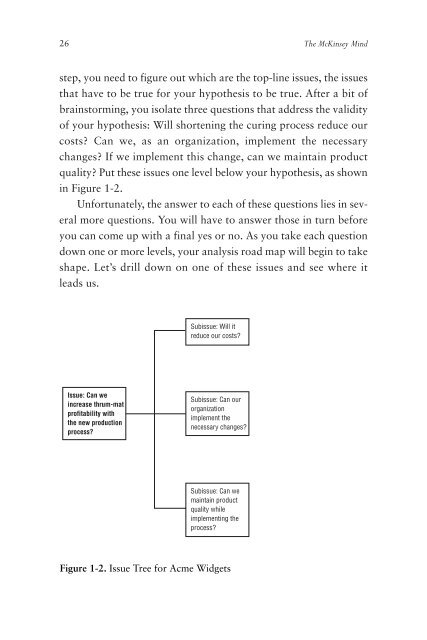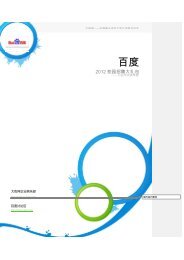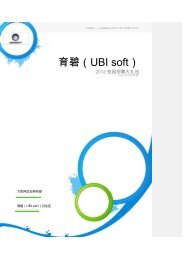- Page 1 and 2: TEAMFLY Team-Fly ®
- Page 3 and 4: This page intentionally left blank.
- Page 5 and 6: Copyright © 2002 by The McGraw-Hil
- Page 7 and 8: This page intentionally left blank.
- Page 9 and 10: This page intentionally left blank.
- Page 11 and 12: x Acknowledgments Pringle, and Paul
- Page 13 and 14: xii Introduction By necessity, The
- Page 15 and 16: xiv Introduction Several senior McK
- Page 17 and 18: xvi Introduction • Business Need
- Page 19 and 20: element later in the book. For now,
- Page 21 and 22: Introduction xix ing Chapter 1 befo
- Page 23 and 24: 1 FRAMING THE PROBLEM Managing •
- Page 25 and 26: Framing the Problem 3 THE McKINSEY
- Page 27 and 28: Framing the Problem 5 ple. I think
- Page 29 and 30: Framing the Problem 7 possible or n
- Page 31 and 32: Framing the Problem 9 We framed the
- Page 33 and 34: Framing the Problem 11 This techniq
- Page 35 and 36: Framing the Problem 13 able to boun
- Page 37 and 38: Framing the Problem 15 on time, mak
- Page 39 and 40: Framing the Problem 17 In a white r
- Page 41 and 42: Framing the Problem 19 guesstimates
- Page 43 and 44: Framing the Problem 21 table, but a
- Page 45 and 46: Framing the Problem 23 sure your su
- Page 47: Framing the Problem 25 Dan Veto fou
- Page 51 and 52: Framing the Problem 29 CONCLUSION B
- Page 53 and 54: 2 DESIGNING THE ANALYSIS Managing
- Page 55 and 56: Designing the Analysis 33 of the te
- Page 57 and 58: Designing the Analysis 35 • Let y
- Page 59 and 60: Designing the Analysis 37 ally corr
- Page 61 and 62: Designing the Analysis 39 reach an
- Page 63 and 64: Designing the Analysis 41 really an
- Page 65 and 66: Table 2-1. Work Plan for Issue in A
- Page 67 and 68: Designing the Analysis 45 Responsib
- Page 69 and 70: Designing the Analysis 47 CONCLUSIO
- Page 71 and 72: 3 GATHERING THE DATA Managing • T
- Page 73 and 74: Gathering the Data 51 RESEARCH STRA
- Page 75 and 76: Gathering the Data 53 of the busine
- Page 77 and 78: Gathering the Data 55 By devoting m
- Page 79 and 80: Gathering the Data 57 the purchase
- Page 81 and 82: Category Name Description Cost Loca
- Page 83 and 84: Gathering the Data 61 book, we used
- Page 85 and 86: Gathering the Data 63 bits of infor
- Page 87 and 88: Gathering the Data 65 upbringing, p
- Page 89 and 90: Gathering the Data 67 Managing Your
- Page 91 and 92: Gathering the Data 69 was a bit mor
- Page 93 and 94: Gathering the Data 71 ning and busi
- Page 95 and 96: Gathering the Data 73 itate resista
- Page 97 and 98: Gathering the Data 75 occurrences,
- Page 99 and 100:
Gathering the Data 77 Culture • U
- Page 101 and 102:
Gathering the Data 79 At McKinsey,
- Page 103 and 104:
Gathering the Data 81 Knowledge tra
- Page 105 and 106:
4 INTERPRETING THE RESULTS Managing
- Page 107 and 108:
Interpreting the Results 85 UNDERST
- Page 109 and 110:
Interpreting the Results 87 half an
- Page 111 and 112:
Interpreting the Results 89 we pres
- Page 113 and 114:
Interpreting the Results 91 That an
- Page 115 and 116:
Interpreting the Results 93 data ca
- Page 117 and 118:
Interpreting the Results 95 In this
- Page 119 and 120:
Interpreting the Results 97 mental
- Page 121 and 122:
Interpreting the Results 99 We’ll
- Page 123 and 124:
Interpreting the Results 101 EXERCI
- Page 125 and 126:
5 PRESENTING YOUR IDEAS Managing
- Page 127 and 128:
Presenting Your Ideas 105 meets thi
- Page 129 and 130:
Presenting Your Ideas 107 sumer goo
- Page 131 and 132:
Presenting Your Ideas 109 Strong co
- Page 133 and 134:
Presenting Your Ideas 111 Figure 5-
- Page 135 and 136:
Presenting Your Ideas 113 have an e
- Page 137 and 138:
Presenting Your Ideas 115 One last,
- Page 139 and 140:
Presenting Your Ideas 117 stacked w
- Page 141 and 142:
Presenting Your Ideas 119 More impo
- Page 143 and 144:
Presenting Your Ideas 121 I was on
- Page 145 and 146:
Presenting Your Ideas 123 when pres
- Page 147 and 148:
Presenting Your Ideas 125 • Ident
- Page 149 and 150:
6 MANAGING YOUR TEAM Managing • T
- Page 151 and 152:
Managing Your Team 129 In this sect
- Page 153 and 154:
Managing Your Team 131 McKinsey alu
- Page 155 and 156:
Managing Your Team 133 of whom prep
- Page 157 and 158:
Managing Your Team 135 IMPLEMENTATI
- Page 159 and 160:
Managing Your Team 137 COMMUNICATIO
- Page 161 and 162:
Managing Your Team 139 Alan Barasky
- Page 163 and 164:
Managing Your Team 141 Let’s comp
- Page 165 and 166:
Managing Your Team 143 BONDING The
- Page 167 and 168:
Managing Your Team 145 Maybe they s
- Page 169 and 170:
Managing Your Team 147 phies, and p
- Page 171 and 172:
Managing Your Team 149 ble, have ot
- Page 173 and 174:
Managing Your Team 151 tions yield
- Page 175 and 176:
Managing Your Team 153 The quantity
- Page 177 and 178:
Managing Your Team 155 mance. The a
- Page 179 and 180:
Managing Your Team 157 CONCLUSION T
- Page 181 and 182:
7 MANAGING YOUR CLIENT Managing •
- Page 183 and 184:
Managing Your Client 161 In fact, M
- Page 185 and 186:
Managing Your Client 163 ing new en
- Page 187 and 188:
Managing Your Client 165 EXERCISES
- Page 189 and 190:
Managing Your Client 167 nization a
- Page 191 and 192:
Managing Your Client 169 the Firm w
- Page 193 and 194:
Managing Your Client 171 not sugges
- Page 195 and 196:
8 MANAGING YOURSELF Managing • Te
- Page 197 and 198:
Managing Yourself 175 tor. Even tho
- Page 199 and 200:
Managing Yourself 177 self, you hav
- Page 201 and 202:
Managing Yourself 179 Obviously, ev
- Page 203 and 204:
Managing Yourself 181 Working backw
- Page 205 and 206:
Managing Yourself 183 Share the loa
- Page 207 and 208:
Managing Yourself 185 You might wan
- Page 209 and 210:
Appendix A DATA-GATHERING RESOURCES
- Page 211 and 212:
Data-Gathering Resources 189 The ma
- Page 213 and 214:
Data-Gathering Resources 191 INDUST
- Page 215 and 216:
Data-Gathering Resources 193 • In
- Page 217 and 218:
Data-Gathering Resources 195 the wo
- Page 219 and 220:
Data-Gathering Resources 197 COMPAN
- Page 221 and 222:
Data-Gathering Resources 199 and to
- Page 223 and 224:
Data-Gathering Resources 201 are lo
- Page 225 and 226:
Data-Gathering Resources 203 Librar
- Page 227 and 228:
Appendix B LESSONS FROM THE McKINSE
- Page 229 and 230:
Lessons from The McKinsey Way 207 A
- Page 231 and 232:
Appendix C IMPLEMENTATION LESSONS T
- Page 233 and 234:
Implementation Lessons 211 Chapter
- Page 235 and 236:
INDEX Academic Universe, 201-2 Acce
- Page 237 and 238:
Index 215 Federal government, 8-9 F
- Page 239 and 240:
Index 217 Performance ratios, 190 P

















